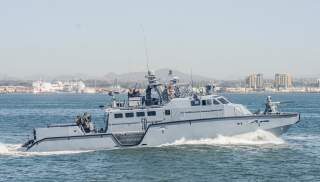Ukraine’s Getting an American Gunboat. How Long Would It Last Against Russia?
The Pentagon has notified the U.S. Congress of its intention to supply the Ukrainian armed forces with $125 million in new assistance. The military aid package includes at least one 85-feet-long Mark VI gunboat, a type in service with the U.S. Navy’s little-known riverine force.
Ukraine could get a powerful new gunboat. But it’s not clear how long it might last in a war with Russia.
The Pentagon has notified the U.S. Congress of its intention to supply the Ukrainian armed forces with $125 million in new assistance.
The military aid package includes at least one 85-feet-long Mark VI gunboat, a type in service with the U.S. Navy’s little-known riverine force.
Acquiring one or more Mark VIs could help Ukraine accelerate the rebuilding of its navy. Russian forces captured or sank almost all of Ukraine’s ships during the invasion of Crimea back in 2014. A naval clash four years later resulted in Russia capturing a Ukrainian navy tugboat and two locally-made Gyurza-M-class gunboats.
The Mark VI possesses capabilities that Ukraine’s existing boats don’t have. But Russian ships in the waters surrounding Ukraine outgun even the Mark VI.
Still, the American boat represents an upgrade for Ukraine. The Mark VI is heavily armed and boasts the latest electronics.
The U.S. Navy acquired an initial dozen Mark VIs to replace older gunboats such as its Riverine Command Boats. In January 2016 two RCBs accidentally strayed into Iranian waters near Farsi Island in the Persian Gulf. Iranian militia forces captured and briefly detained both boats and the 10 American sailors aboard them.
Compared to the RCB, “the Mark VI is in another league all together,” David Larter explained in a story for Defense News. The Mark VI with its 10-person crew packs four .50-caliber machine guns and two 25-millimeter cannons.
“We’ve demonstrated that we can sustain a firefight for 45 minutes in the Mark VI,” Senior Chief Derrick Cox, a riverine trainer, told Larter.
“The new Mark VI has a communications suite that well exceeds that of the RCB,” Larter added. “The new boat can connect with the fleet via Link 16; it also has high- and ultrahigh-frequency and satellite comms so shore side controllers won’t lose track of the boat, as happened during the Farsi Island incident. The 85-foot boat has a top speed of more than 40 knots and a range of up to 500 miles.”
After the Russian annexation of Crimea, Ukraine was left with just one large warship—the 404-foot-long frigate Hetman Sahaydachniy—plus a few dozen smaller boats. Hopelessly outgunned by the much larger Russian navy, the Ukrainian navy hurriedly launched production of the 75-feet-long Gyurza-M-class gunboats. Kiev plans to build 20 of the boats but, as of 2020, has completed just seven.
Two of the boats spent two years in Russian impound following an incident along the Russian-controlled Kerch Strait connecting the Black Sea and the smaller Sea of Azov in November 2018.
The Sea of Azov lies between Crimea and the Russian mainland, and is bordered by a number of Ukrainian ports, including the major city of Mariupol, which is near the front lines in the Donbass region of Ukraine, where Kiev’s troops battle rebels backed by Russia.
The confrontation began when the Ukrainian navy tugboat Yana Kapu and the Gyurza-M-class gunboats Berdyansk and Nikopol set sail from Odessa, Ukraine’s main port on the Black Sea.
They sailed east around Crimea and toward the narrow Kerch Strait, which Russia spanned with a bridge after its forced annexation of Crimea in 2014.
As the three vessels approached the Kerch Strait, the Russians towed a cargo vessel across the narrow passage, preventing the Ukrainians from entering the Sea of Azov.
Russian and Ukrainian troops exchanged fire and Russian Su-25 attack planes and Ka-52 attack helicopter flew overhead. A Russian coast guard vessel rammed the Ukrainian tug. Russian troops then boarded all three Ukrainian boats and captured 24 sailors.
A year later in late 2019 Moscow repatriated all three Ukrainian boats and their crews.
While the Mark VI is bigger and more powerful than a Gyurza-M is, there’s little reason to believe the American-made boat would fare better in a similar clash with Russian forces, to say nothing of the Mark VI’s chances during a major war.
Where Ukraine in total operates just one aging frigate and fewer than a dozen gunboats, Russia’s Black Sea fleet alone possesses a cruiser, a destroyer, five frigates and seven submarines, not to mention a couple of dozen patrol boats.
David Axe serves as Defense Editor of the National Interest. He is the author of the graphic novels War Fix, War Is Boring and Machete Squad.

